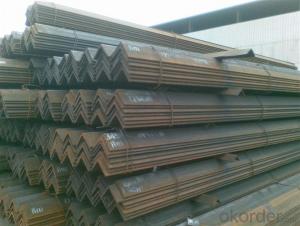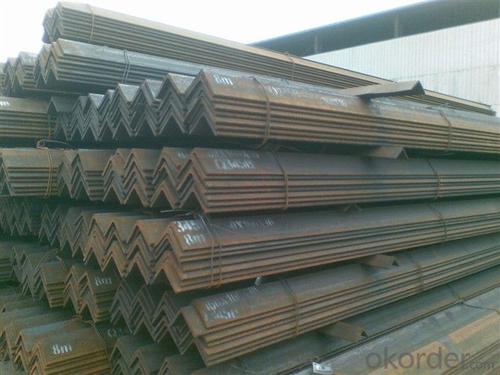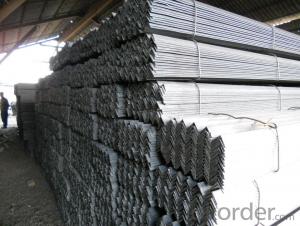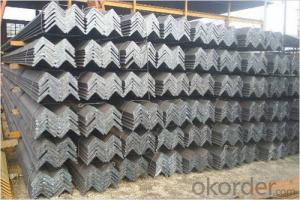Equal Angle steel Hot rolled in Steel Angles Q235, Q345
- Loading Port:
- Tianjin
- Payment Terms:
- TT or LC
- Min Order Qty:
- 25 m.t.
- Supply Capability:
- 40000 m.t./month
OKorder Service Pledge
OKorder Financial Service
You Might Also Like
Product Description:
OKorder is offering Equal Angle steel Hot rolled in Steel Angles Q235, Q345 at great prices with worldwide shipping. Our supplier is a world-class manufacturer of steel, with our products utilized the world over. OKorder annually supplies products to European, North American and Asian markets. We provide quotations within 24 hours of receiving an inquiry and guarantee competitive prices.
Product Applications:
Equal Angle steel Hot rolled in Steel Angles Q235, Q345 are ideal for structural applications and are widely used in the construction of buildings and bridges, and the manufacturing, petrochemical, and transportation industries.
Product Advantages:
OKorder's Equal Angle steel Hot rolled in Steel Angles Q235, Q345 are durable, strong, and resist corrosion.
Main Product Features:
· Premium quality
· Prompt delivery & seaworthy packing (30 days after receiving deposit)
· Corrosion resistance
· Can be recycled and reused
· Mill test certification
· Professional Service
· Competitive pricing
Product Specifications:
1.High quality
2.Suitable price
3.Factory provide directly.
4.Size: 2#-20# /4.5#-20#
Standard:AISI,ASTM,GB,JIS
Dimensions:
1. Equal Angle: 25*25*3mm- 200*200*14/16/18/20mm
2.Unequal Angle: 45*30*4mm-200*125*12/14/16/18mm
Grade:Q235-Q345 Series
Angle steel: equal/Unequal angle bar
Hot rolled angle steel
Material:Q235 Q345
Size:
1. Equal Angle: 25*25*3mm- 200*200*14/16/18/20mm
2.Unequal Angle: 45*30*4mm-200*125*12/14/16/18mm
length: 6m 9m 12m or as urs
packages:2 tons per bundles
Equal angle steel, hot rolled angle steel, steel angle
| Dimension (mm) | Weight(kg/m) | Dimension (mm) | Weight(kg/m) |
| 20*3 | 0.89 | 80*10 | 11.87 |
| 20*4 | 1.15 | 90*6 | 8.35 |
| 25*3 | 1.12 | 90*7 | 9.66 |
| 25*4 | 1.46 | 90*8 | 10.95 |
| 30*3 | 1.37 | 90*10 | 13.48 |
| 30*4 | 1.79 | 90*12 | 15.94 |
| 36*3 | 1.66 | 100*6 | 9.37 |
| 36*4 | 2.16 | 100*7 | 10.83 |
| 36*5 | 2.65 | 100*8 | 12.28 |
| 40*3 | 1.85 | 100*10 | 15.12 |
| 40*4 | 2.42 | 100*12 | 17.9 |
| 40*5 | 2.98 | 100*14 | 20.61 |
| 45*3 | 2.09 | 100*16 | 23.26 |
| 45*4 | 2.74 | 110*7 | 11.93 |
| 45*5 | 3.37 | 110*8 | 13.53 |
| 45*6 | 3.99 | 110*10 | 16.69 |
| 50*3 | 2.33 | 110*12 | 19.78 |
| 50*4 | 3.06 | 110*14 | 22.81 |
| 50*5 | 3.77 | 125*8 | 15.5 |
| 50*6 | 4.46 | 125*10 | 19.13 |
| 56*3 | 2.62 | 125*12 | 22.7 |
| 56*4 | 3.45 | 125*14 | 26.19 |
| 56*5 | 4.25 | 140*10 | 21.49 |
| 56*8 | 6.57 | 140*12 | 25.52 |
| 63*4 | 3.91 | 140*14 | 29.49 |
| 63*5 | 4.82 | 140*16 | 33.39 |
| 63*6 | 5.72 | 160*10 | 24.73 |
| 63*8 | 7.47 | 160*12 | 29.39 |
| 63*10 | 9.15 | 160*14 | 33.99 |
| 70*4 | 4.37 | 160*16 | 38.52 |
| 70*5 | 5.4 | 180*12 | 33.16 |
| 70*6 | 6.41 | 180*14 | 38.38 |
| 70*7 | 7.4 | 180*16 | 43.54 |
| 70*8 | 8.37 | 180*18 | 48.63 |
| 75*5 | 5.82 | 200*14 | 42.89 |
| 75*6 | 6.91 | 200*16 | 48.68 |
| 75*7 | 7.98 | 200*18 | 54.4 |
| 75*8 | 9.03 | 200*20 | 60.06 |
| 75*10 | 11.09 | 200*24 | 71.17 |
| 80*5 | 6.21 | ||
| 80*6 | 7.38 | ||
| 80*7 | 8.53 | ||
| 80*8 | 9.66 |
unequal anlge steel is also ok for us
| Dimension (mm) | Weight(kg/m) | Dimension (mm) | Weight(kg/m) |
| 25*16*3 | 0.91 | 100*63*6 | 7.55 |
| 25*16*4 | 1.18 | 100*63*7 | 8.72 |
| 32*20*3 | 1.17 | 100*63*8 | 9.88 |
| 32*20*4 | 1.52 | 100*63*10 | 12.1 |
| 40*25*3 | 1.48 | 100*80*6 | 8.35 |
| 40*25*4 | 1.94 | 100*80*7 | 9.66 |
| 45*28*4 | 1.69 | 100*80*8 | 10.9 |
| 45*28*5 | 2.2 | 100*80*10 | 13.5 |
| 50*32*3 | 1.91 | 110*70*6 | 8.35 |
| 50*32*4 | 2.49 | 110*70*7 | 9.66 |
| 56*36*3 | 2.15 | 110*70*8 | 10.9 |
| 56*36*4 | 2.82 | 110*70*10 | 13.5 |
| 56*36*5 | 3.47 | 125*80*7 | 11.1 |
| 63*40*4 | 3.19 | 125*80*8 | 12.6 |
| 63*40*5 | 3.92 | 125*80*10 | 15.5 |
| 63*40*6 | 4.64 | 125*80*12 | 18.3 |
| 63*40*7 | 10 | 140*90*8 | 14.2 |
| 70*45*4 | 3.57 | 140*90*10 | 17.5 |
| 70*45*5 | 4.4 | 140*90*12 | 20.7 |
| 70*45*6 | 5.22 | 140*90*14 | 23.9 |
| 70*45*7 | 6.01 | 160*100*10 | 19.9 |
| 75*50*5 | 4.81 | 160*100*12 | 23.6 |
| 75*50*6 | 5.7 | 160*100*14 | 27.2 |
| 75*50*8 | 7.43 | 160*100*16 | 30.8 |
| 75*50*10 | 9.1 | 180*110*10 | 22.3 |
| 80*50*5 | 5 | 180*110*12 | 26.5 |
| 80*50*6 | 5.93 | 180*110*14 | 30.6 |
| 80*50*7 | 6.85 | 180*110*16 | 34.6 |
| 80*50*8 | 7.75 | 200*125*12 | 29.8 |
| 90*56*5 | 5.66 | 200*125*14 | 34.4 |
| 90*56*6 | 6.72 | 200*125*16 | 39 |
| 90*56*7 | 7.76 | 200*125*18 | 43.6 |
| 90*56*8 | 8.78 |
FAQ:
Q1: Why buy Materials & Equipment from OKorder.com?
A1: All products offered byOKorder.com are carefully selected from China's most reliable manufacturing enterprises. Through its ISO certifications, OKorder.com adheres to the highest standards and a commitment to supply chain safety and customer satisfaction.
Q2: How do we guarantee the quality of our products?
A2: We have established an advanced quality management system which conducts strict quality tests at every step, from raw materials to the final product. At the same time, we provide extensive follow-up service assurances as required.
Q3: How soon can we receive the product after purchase?
A3: Within three days of placing an order, we will begin production. The specific shipping date is dependent upon international and government factors, but is typically 7 to 10 workdays.
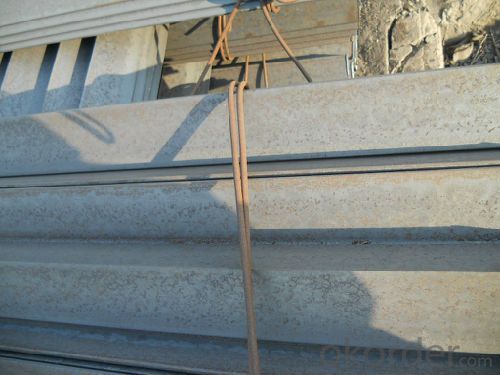
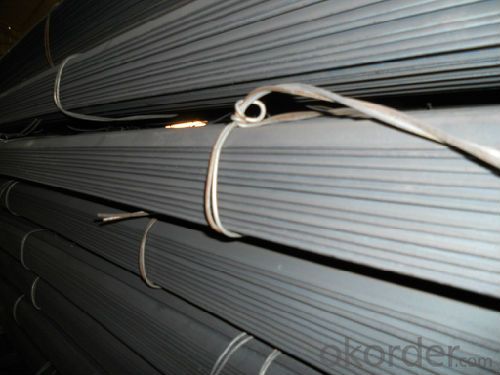
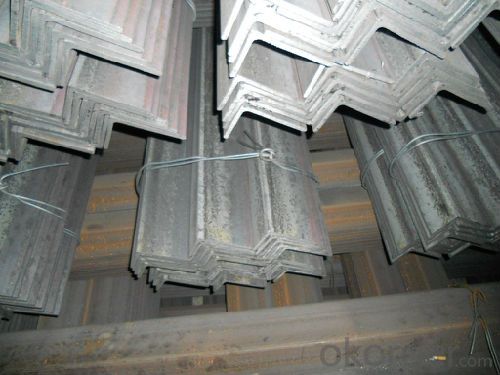
- Q: How are steel angles used in structural framing?
- Structural framing relies heavily on the utilization of steel angles to ensure support and stability for various building components. These angles, characterized by their L-shaped form, serve to connect and reinforce different elements within a structure, including beams, columns, and trusses. A primary function of steel angles in structural framing is to enhance the strength and rigidity of beams and columns. By affixing steel angles to the sides of these components, they function as braces, effectively preventing buckling or bending under heavy loads. This becomes particularly crucial in large-scale construction projects, where the overall structural integrity of the building is of utmost importance. Moreover, steel angles find application in establishing connections between different structural members. For instance, they can be utilized to securely join beams with columns, ensuring a steadfast and stable joint. Typically, the angles are either bolted or welded to both members, resulting in a resilient and long-lasting connection. In addition to their role in connections, steel angles can also be employed to create frameworks for walls, roofs, and floors. By attaching angles to the top and bottom of these components, a robust framework is established, capable of supporting the weight of the structure above and providing stability throughout the construction process. To summarize, steel angles are indispensable in structural framing due to their ability to provide support, reinforce connections, and establish stable frameworks. Their versatility and strength render them an essential component within the construction industry.
- Q: Can steel angles be used for manufacturing playground equipment?
- Indeed, playground equipment can be manufactured using steel angles. Steel angles, renowned for their robustness and endurance, are extensively utilized in construction and manufacturing industries. These angles can be employed to construct the framework and support structures of diverse playground equipment, including slides, climbing frames, and swing sets. The adaptability of steel angles enables the production of secure and steadfast playground equipment capable of enduring rigorous utilization and adverse weather conditions. Furthermore, steel angles can be effortlessly welded, cut, and molded to meet precise design specifications, rendering them an ideal preference for playground equipment manufacturers.
- Q: What are the common design codes and standards for steel angles?
- The common design codes and standards for steel angles depend on the specific application and industry requirements. However, some widely recognized design codes and standards applicable to steel angles include: 1. American Institute of Steel Construction (AISC): AISC provides design specifications and standards for structural steel construction, including angles. The AISC Steel Construction Manual offers guidance on the design of steel structures, including the selection and design of steel angles. 2. American Society for Testing and Materials (ASTM): ASTM International develops and publishes technical standards for various materials, including steel. ASTM A36/A36M is a commonly referenced standard for carbon structural steel, including angles. It specifies the requirements for chemical composition, mechanical properties, and testing methods. 3. European Norm (EN): The European Norm specifies technical delivery conditions for structural steel products. EN 10025-2 covers non-alloy structural steels, including angles, and provides requirements for chemical composition, mechanical properties, and tolerances. 4. British Standards Institution (BSI): The BSI publishes a range of standards relating to steel angles, including BS EN 10056-1, which details the dimensions and tolerances for hot-rolled equal and unequal steel angles. 5. Canadian Standards Association (CSA): CSA standards provide guidance for steel design and construction in Canada. CSA G40.21 is a widely used standard that covers the requirements for general structural steel, including angles. It is important to note that these are just some examples of the common design codes and standards for steel angles. Depending on the specific project and geographic location, there may be additional local or industry-specific codes and standards that need to be considered when designing and specifying steel angles. Consulting with a structural engineer or referring to the relevant design codes and standards is crucial to ensure compliance and safety in the design and construction of steel angles.
- Q: Can steel angles be used for fencing?
- Indeed, steel angles possess the potential for fencing. The utilization of steel angles is prevalent in fencing applications owing to their robustness, endurance, and adaptability. They furnish a solid structure for the fence, guaranteeing steadiness and security. The installation of steel angles is a task easily accomplished, and their configuration permits an array of fence designs and heights. Moreover, they exhibit resistance to rust and corrosion, rendering them appropriate for outdoor utilization. In summary, steel angles emerge as a favored option for fencing endeavors due to their structural soundness and enduring effectiveness.
- Q: Can steel angles be used for manufacturing outdoor benches?
- Yes, steel angles can be used for manufacturing outdoor benches. Steel angles provide strength, durability, and stability, making them suitable for outdoor use. Additionally, steel angles can withstand weather elements such as rain, sun exposure, and temperature changes, ensuring the longevity of the outdoor benches.
- Q: What are the common surface treatments for steel angles to enhance corrosion resistance?
- The common surface treatments for steel angles to enhance corrosion resistance include galvanizing, painting, and powder coating.
- Q: How do you specify steel angles in a construction project?
- When specifying steel angles in a construction project, one must consider their dimensions, grade, and any additional requirements. The dimensions are typically described as the length of each leg and the thickness of the material. For instance, a common specification may be "2-inch by 2-inch by 1/4-inch steel angle". The grade of the steel angle is also crucial to determine its strength and durability. Common grades include A36, A572, and A588. The selection of the grade depends on the project's structural requirements and environmental conditions. Apart from dimensions and grade, any additional requirements like corrosion resistance, fire resistance, or special finishes should be clearly stated. For example, if the steel angles will be exposed to outdoor elements, they might need to be hot-dip galvanized or coated with a protective paint. It is essential to refer to relevant codes and standards, such as the American Institute of Steel Construction (AISC) manual, for guidance on specifying steel angles in a construction project. These codes provide guidelines on allowable stress, design criteria, and other factors to ensure the safe and efficient use of steel angles in structural applications.
- Q: Can steel angles be drilled or cut?
- Indeed, it is possible to drill or cut steel angles. Steel angles, being a flexible structural material, find extensive use in diverse construction and manufacturing endeavors. It is effortless to drill them for the purpose of creating holes for bolts, screws, or other fastening elements. Moreover, steel angles can be fashioned into specific lengths or shapes by employing tools like saws, plasma cutters, or shears. The capacity to drill or cut steel angles renders them exceedingly adaptable and fitting for an extensive array of applications.
- Q: Are steel angles resistant to fire?
- Steel angles are generally considered to be fire resistant. Steel is a non-combustible material, meaning it does not burn or contribute to the spread of fire. However, it is important to note that while steel itself is resistant to fire, it can lose its strength when exposed to high temperatures for an extended period of time. In a fire situation, the temperature can rise rapidly, causing the steel to weaken and potentially compromise the structural integrity of a building or component. To enhance fire resistance, steel angles can be protected by applying fire-resistant coatings, such as intumescent paint or fireproofing materials. These coatings can provide additional insulation, delaying the steel's exposure to high temperatures and preventing its failure. Ultimately, the fire resistance of steel angles depends on various factors, including the duration and intensity of the fire, as well as the measures taken to enhance their fire performance. It is essential to consult with fire protection experts and adhere to building codes and regulations to ensure the appropriate level of fire resistance for steel angles in a specific application.
- Q: How are steel angles protected against abrasion?
- Steel angles are commonly used in construction and industrial applications, where they are subject to various forms of abrasion. To protect steel angles against abrasion, several methods are employed. One common method is the application of protective coatings. These coatings can be in the form of paints, epoxy coatings, or other specialized coatings designed for abrasion resistance. The coatings act as a barrier between the steel surface and the abrasive elements, preventing direct contact and reducing the wear and tear caused by friction. Another method is the use of rubber or plastic linings. These linings are typically applied to the surfaces of the steel angles that are most prone to abrasion. The rubber or plastic material absorbs the impact of abrasive forces, cushioning the steel and reducing the wear rate. Additionally, these linings provide an extra layer of protection against corrosion and chemical attacks. In some cases, steel angles may undergo a process called hardening or heat treatment. This involves subjecting the steel to high temperatures and then rapidly cooling it. This process alters the microstructure of the steel, making it harder and more resistant to abrasion. Heat-treated steel angles are commonly used in high-wear environments such as mining and material handling industries. Furthermore, engineers may opt to design steel angles with specific profiles or shapes that offer better resistance to abrasion. These profiles can include rounded edges, chamfers, or other features that minimize direct contact with abrasive materials. Overall, the protection against abrasion for steel angles involves a combination of protective coatings, linings, heat treatment, and thoughtful design. By implementing these measures, the lifespan and performance of steel angles can be significantly prolonged, reducing maintenance costs and ensuring their durability in abrasive environments.
Send your message to us
Equal Angle steel Hot rolled in Steel Angles Q235, Q345
- Loading Port:
- Tianjin
- Payment Terms:
- TT or LC
- Min Order Qty:
- 25 m.t.
- Supply Capability:
- 40000 m.t./month
OKorder Service Pledge
OKorder Financial Service
Similar products
Hot products
Hot Searches
Related keywords
